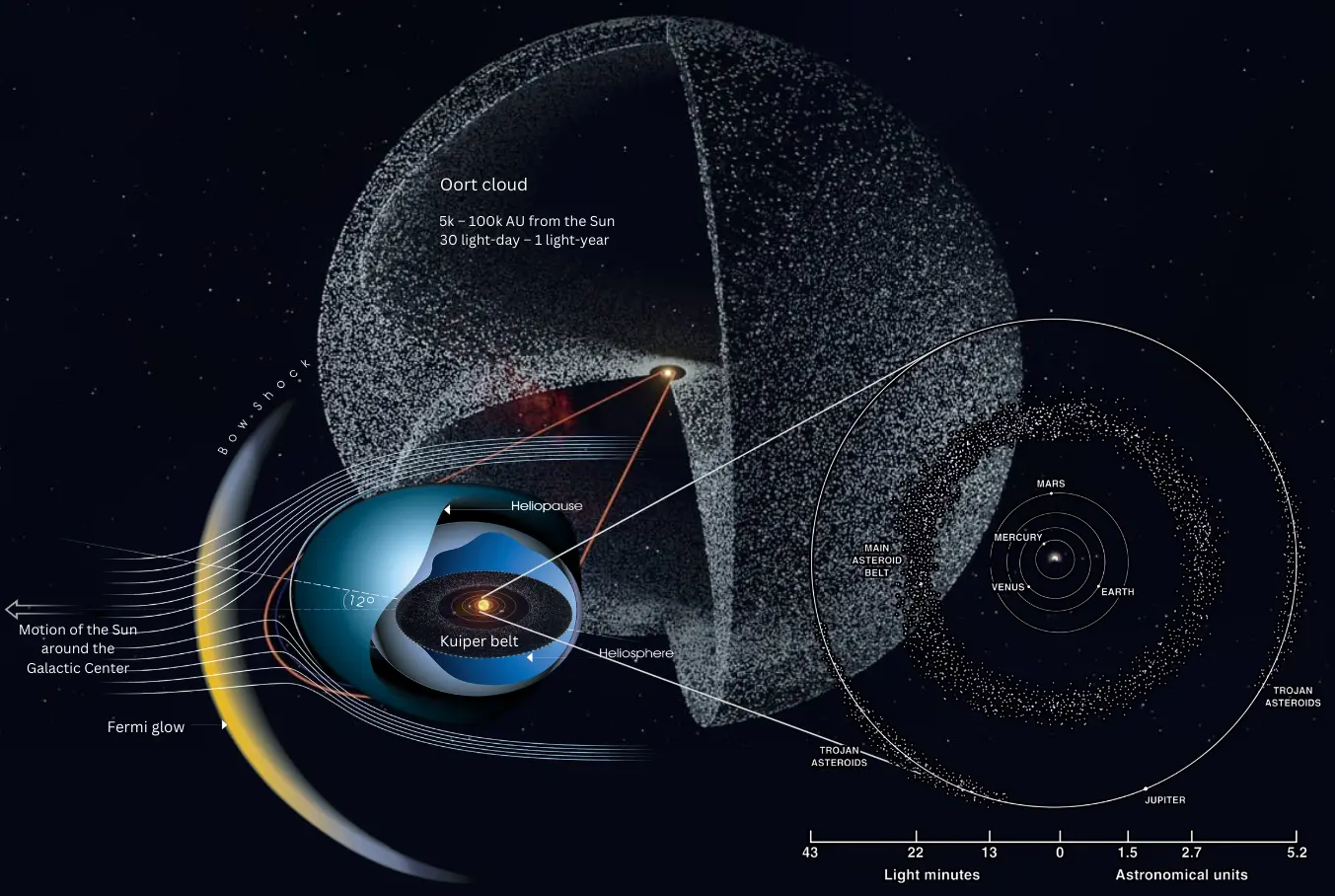Table of Contents
Solar system
The solar system consists of the sun and all the objects under its gravity. There are eight planets, dozens of dwarf planets, hundreds of moons, asteroids, and comets. Each planet in this system is unique, with many more variations in asteroids and comets. The entire system is again surrounded by a huge Oort cloud made up of billions of ice pieces. But looming over all diversity is the underlying order of the solar system. Most of it revolves around the Sun in a thin disk in roughly the same direction. For those who have revolution as well as rotation, the direction of both motions is the same. This order suggests how our system was born from a giant cloud of gas and dust four and a half billion years ago. Traces of that cloud’s motion remain in every object that fragmented long ago from the cloud.
Near the center of the solar system is the sun, which is 700 times more massive than everything else in the system combined. Our star is essentially a ball of gas made up of 71% hydrogen and 27% helium. But it also contains all other chemical elements in small amounts in gaseous state.
The four inner planets (Mercury, Venus, Earth, Mars) are found closest to the Sun, whose orbits are shown in the lower right corner of the figure above. They are mainly made of rock and their atmospheres are either very thin or non-existent. The orbits of the four outer planets (Jupiter, Saturn, Uranus, Neptune) are shown at lower left, although Jupiter’s orbit is also shown enlarged at right. They are composed mainly of gas and liquid, are much larger than the four inner planets, and have much thicker hydrogen-filled atmospheres. Jupiter’s diameter is ten times that of Earth, and its mass is 318 times. The inner planets are sometimes called terrestrial planets because they resemble Earth, and the outer planets are often called jovian planets because they resemble Jupiter.
There are also many dwarf planets in the solar system, the best example of which is Pluto, which is smaller than the Moon. Pluto’s orbit extends far above and below the solar disk. The larger dwarf planet Eris is closer to the Sun. Dwarf planets are almost spherical in appearance like planets, but they cannot form independent sovereign orbits like planets.
Besides, most of the planets are surrounded by satellites, which are now called moons after our moon. Jupiter and Saturn have more than sixty moons, Uranus twenty-seven, Neptune fourteen, Mars two, Earth one; Only Venus and Mercury have no moon.
There are millions of objects in the solar system much smaller than planetary satellites. Asteroids are mainly made of rock and metal. Due to less mass, they could not be spherical. The largest asteroid Vesta is egg-shaped, about five hundred km long, while the diameter of the Earth is twelve thousand km, the Moon is three and a half thousand km. Our nearest rocky asteroids lie in the asteroid belt (lower right in the figure) between Mars and Jupiter, where there are hundreds of thousands of asteroids. Some asteroids are also found in Jupiter’s orbit, called Trojans.
There are also a few asteroids in the Kuiper Belt (bottom left of the figure) farther than Neptune, but most of the objects there are icy bodies, tiny chunks of ice. However, the largest number of icy bodies is in the Oort cloud whose scale is shown in the top panel of the figure. The Kuiper Belt is only 50 AU from the Sun, but the edge of the Oort Cloud is 100,000 AU, or about 1 lightyear. Between these two belts there may be as many as a trillion icy bodies, averaging ten km in size. When they come close to the Sun in large elliptical orbits, we call them comets. The comet’s tail is made of ice melted by the sun’s heat.
The Sun’s solar wind, however, cannot reach the Oort cloud, the boundary where it stops due to the pressure of the interstellar wind after crossing the Kuiper Belt is called the heliopause. Just before the heliopause, the collision of the solar and stellar winds creates a bow shock as the Sun moves around the center of the Milky Way, shown in the lower left corner of the figure above. This is the extent of our heliosphere.
1. Planets
Distance from the sun is in astronomical unit (AU), mass is in $10^{24}$ kg, density in g cm$^{-3}$, and the temperatures ($T$) in kelvin (K).
| Name | Distance | Moons | Mass | Density | Observed $T$ | Predicted $T$ |
|---|---|---|---|---|---|---|
| Mercury | 0.39 | 0 | 0.33 | 5.4 | 100–725 | 451 |
| Venus | 0.72 | 0 | 4.87 | 5.2 | 733 | 260 |
| Earth | 1.00 | 1 | 5.97 | 5.5 | 288 | 255 |
| Mars | 1.52 | 2 | 0.64 | 3.9 | 215 | 222 |
| Jupiter | 5.20 | 63 | 1898.6 | 1.3 | 124 | 104 |
| Saturn | 9.54 | 56 | 568.5 | 0.69 | 95 | 79 |
| Uranus | 19.2 | 27 | 86.8 | 1.32 | 59 | 58 |
| Neptune | 30.1 | 13 | 102.4 | 1.64 | 59 | 55 |
